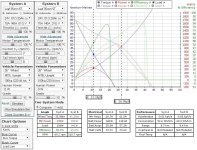teslanv said:
Coming back to the Myth a little here:
Is it fair to say that for a given motor design (And negating any controller inefficiencies), if you were to compare a 16X4-Turn motor to a 8X8-turn motor, could you accurately say that:
For a given battery voltage at 100% Throttle, the 16X4-Turn motor will spin exactly twice as fast as the 8X8-Turn motor and for a given battery and phase current profile (amperage) the 8X8-turn motor will produce twice the torque as the 16X4-Turn motor.
Or to say this statement a different way:
It takes twice as much voltage for an 8X8-turn motor to spin at the same RPM as a 16X4-turn motor, and it takes twice as much current for the 16X4-turn motor to produce the same torque as the 8X8-turn motor.
I am not trying to propagate any more myth here, just trying to confirm that what I understand about the relationship between a motor's winding, and Speed and torque are accurate.
Anytime the motors with differing Kv in your example are at the same RPM getting the same input power, they will be making exactly the same amount of torque output, as well as the same amount of heat produced to make that torque as well as identical efficiency and battery current etc.
In your example, the motor with half the turns gets twice the RPM range of the other of course.


